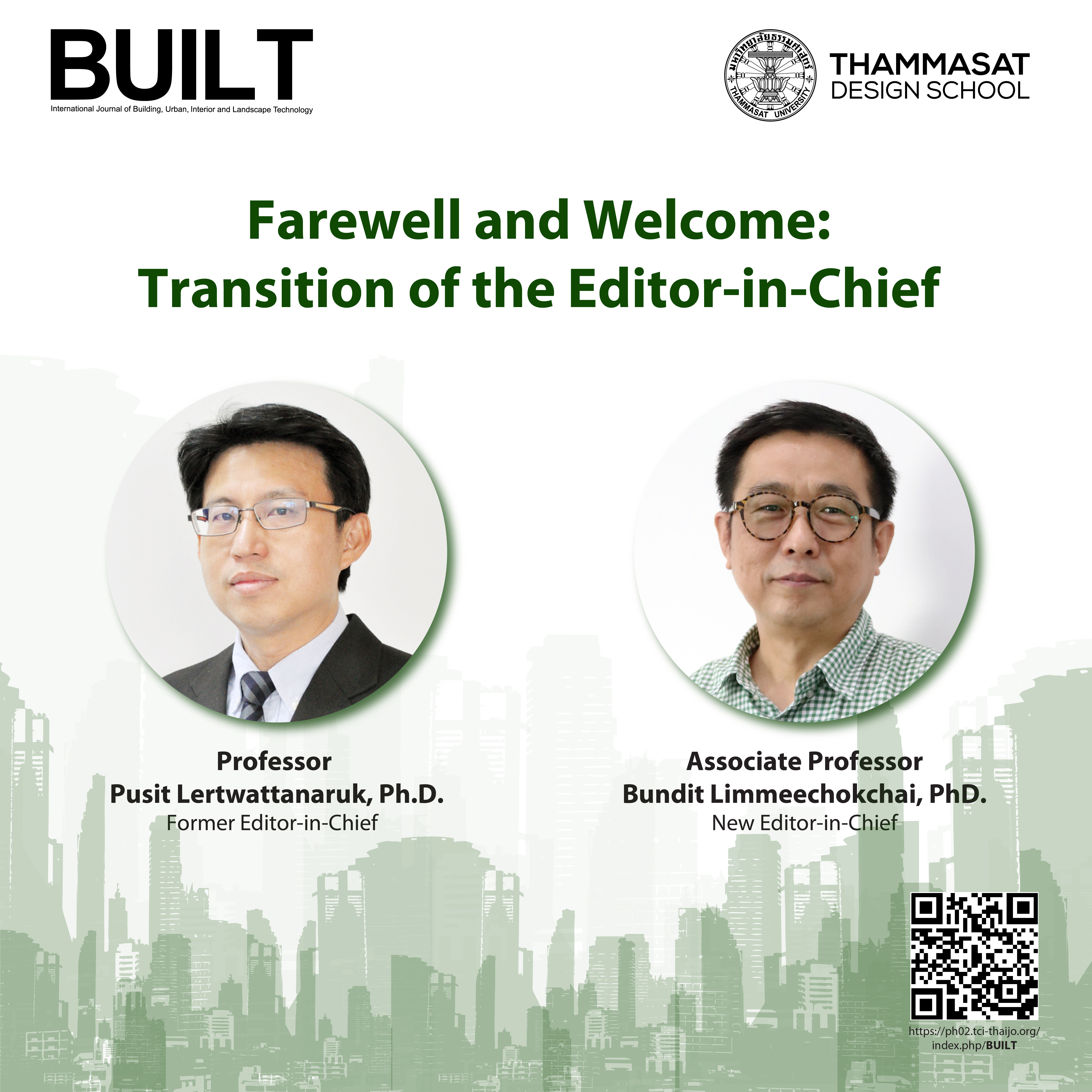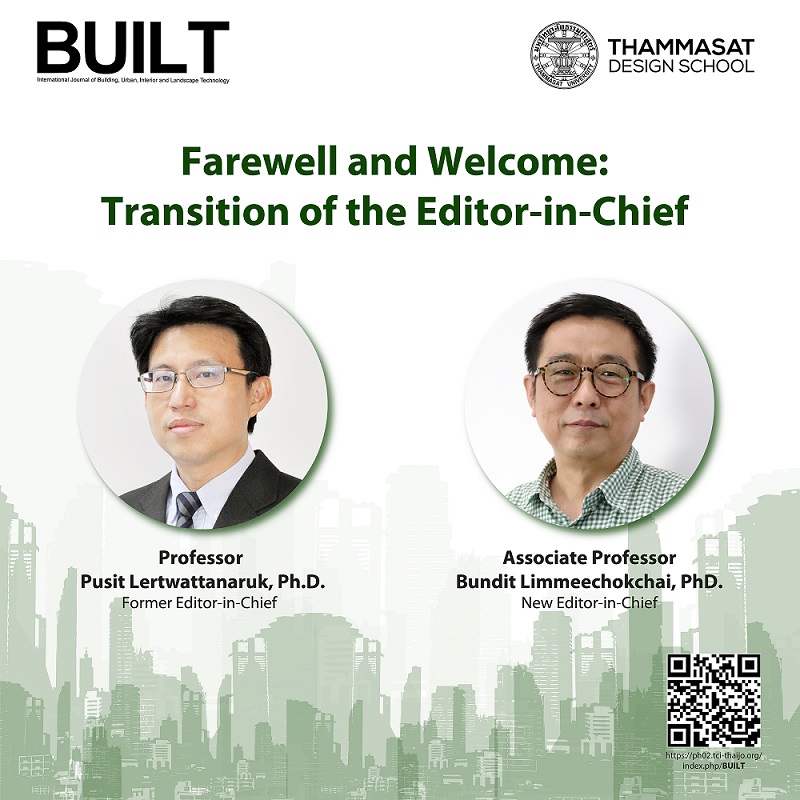


BUILT: International Journal of Building, Urban, Interior and Landscape Technology
AIMS AND SCOPE:
BUILT is a peer-reviewed journal that focuses on original research in architectural and technological applications on an international level. The journal welcomes contributors in the field of "Building", "Urban" "Interior" and "Landscape" environments to showcase the cutting-edge "Technology" in architectural research. The structure and direction of this journal cater to the needs of both academic and professional audiences. Each article will be divided into two main parts including "Theory" and "Applications". The former focuses on theoretical research of authors' expertise, while the latter allows authors to discuss the architectural applications utilized his/her 'practice-oriented' research. This journal aims to benefit the wider community by providing tailored scientific journal papers. Professionals and researchers are invited to contribute their ideas and expertise, cultivating a collaborative environment for sharing insights among peers. Moreover, it functions as an educational platform, offering audiences exposure to innovative ideas and knowledge.
Topics such as the following are welcome:
TYPE OF MANUSCRIPTS:
Please ensure that the appropriate type of manuscripts from the following lists must be selected when submitting.
|
|
Research papers submitted to BUILT should be well-organized, clearly written, and thoroughly researched. They must be original manuscripts with a maximum length of 8000 words, inclusive of tables, figures, and references. The papers should present innovative research that has the potential to make a significant and long-lasting contribution to both research and practice in the relevant fields. Manuscripts that aim to initiate an ongoing debate on a particular issue or expand on conference proceedings related to the research and practice of the fields are also welcome.
An article review provides a comprehensive summary of literature within the scope of fields falling under BUILT. It allows scholars to analyze and evaluate the work of other experts within their respective fields. BUILT typically invites leading experts to prepare article reviews; however, authors with an interest in this section are also encouraged to submit their reviews. Manuscripts should be approximately 1,500-3,500 words.
"Case Studies in Building, Urban, Interior, and Landscape Technologies" is a platform for the rapid publication of case studies, focusing on real projects and short communications. The authors offer a valuable collection of case studies that can benefit engineers, architects, designers, planners, researchers, and other professionals who are interested in technology and solving practical problems. The case study manuscript should preferably be between 3,500-5,000 words in length.
Book reviews offer critical overviews of books related to BUILT's scope published within the last five years. The review should be approximately 1,500-4,000 words and include a critical evaluation of the academic contribution of the book. Book reviews may be submitted by invitation or voluntarily.
|
PUBLICATION FREQUENCY:
BUILT published bi-annually (2 issues per year):
LANGUAGE:
BUILT accepts manuscripts in both Thai and English. For English submissions, manuscripts must be written with proper grammar and spelling. It is highly recommended to have a native English speaker review the manuscript. All submitted manuscripts will be undergo plagiarism checks, including self-plagiarism and dishonesty. Manuscripts that do not pass the plagiarism check will be rejected.
OPEN ACCESS:
Since 2018, the BUILT journal has implemented an online submission platform and open access approach through Thai Journals Online (ThaiJO). The platform was developed using the OJS system (Online Journal System) by NECTEC (National Electronics and Computer Technology Center) and TCI (Thai-Journal Citation Index Centre). This approach allows researchers to make their work accessible to readers from all around the world. For more information, please visit https://www.tci-thaijo.org/about.
CONTENT REGISTRATION:
From 2022 onwards, BUILT will use Digital Object Identifier (DOI) provided by CrossRef to identify all published articles. This will be applied retrospectively to all previously published articles as well. The use of DOI by CrossRef has several benefits, including providing richer metadata, making content more useful and easier to find. Additionally, articles are able to distribute their metadata downstream, making it available to numerous systems and organizations. This aids in crediting the work, reporting the impact of funding, and tracking outcomes and activity.
OWNERSHIP AND MANAGEMENT:
The BUILT journal is published by the Faculty of Architecture and Planning, Thammasat University, Thailand. The editorial management is overseen by the Editor-in-Chief and Associate Editor-in-Chief, with support from the editorial board members and staff.
PUBLICATION FEE:
There are no fees or charges at any stage of the publication process.
REVENUE SOURCES:
The BUILT journal is funded by Thammasat University's Faculty of Architecture and Planning. However, the editorial board makes all review decisions independently.
ADVERTISING AND DIRECT MARKETING:
BUILT's journal policy excludes advertising. However, BUILT may consider publishing articles that are requested by professional societies and submitted as part of their professional activities, such as conferences, seminars, workshops, and symposia. These solicited articles will undergo the same review process as all other articles.
JOURNAL HISTORY:
BUILT is a journal that was established in 2010 and published its first issue in 2011. Over the past decade, it has evolved into the most widely cited open-access journal in the field of Building, Urban, Interior, and Landscape Technology, with its latest volume publishing over 130 articles. The journal employs a rigorous peer review process and is indexed by the Thai-Journal Citation Index Centre (TCI). As we enter 2024, BUILT will continue to focus on launching an open-access journal devoted to short-form articles and developing the journal's accessibility manual. To manage the increased workload, BUILT has welcomed new volunteer editors and associate editors. The journal is published and sponsored by the Faculty of Architecture and Planning at Thammasat University in Thailand.


 |
All material is licensed under the terms of the Creative Commons Attribution 4.0 International (CC-BY-NC-ND 4.0) License, unless otherwise stated. |

